The Ultimate Guide to Adobe Experience Cloud
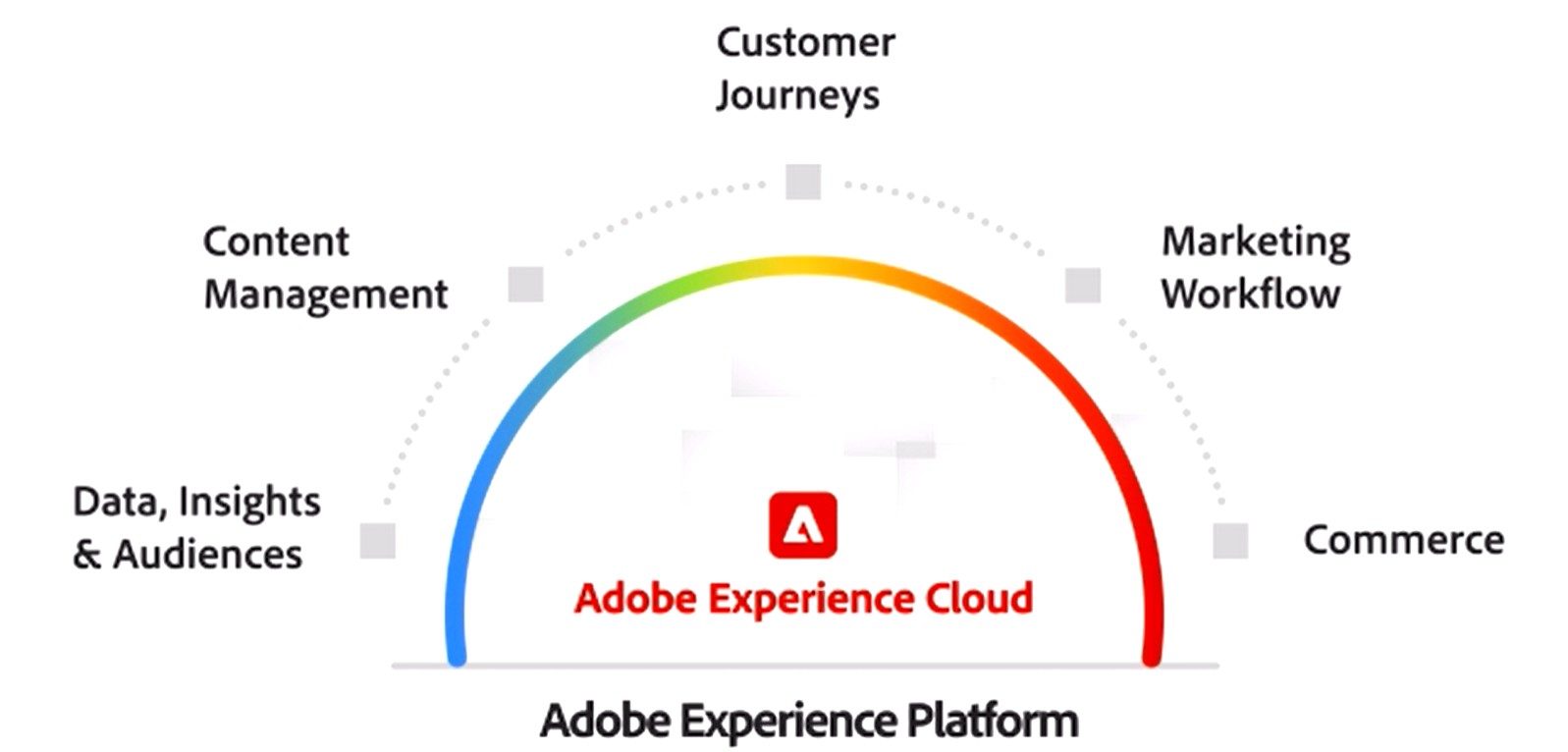
In the following article, we explore Adobe Experience Cloud – a suite of digital marketing tools designed to help businesses deliver personalized experiences across various channels. The platform combines customer data, analytics, and content management capabilities to help companies better understand their customers, creating tailored experiences that meet their unique needs.
You can use Adobe Experience Cloud to run marketing campaigns, track customer interactions, and analyze real-time performance data. The platform also offers a range of tools for creating and managing content for web and mobile apps, emails, and social media.
Below, we explore all Adobe Experience Cloud tools and provide their closest competitors. You will find a table of Adobe Experience Cloud products defined. After that, we describe the most essential instruments in more detail. You will also discover a section that highlights Adobe Experience Cloud benefits and competitive advantages. And there is a short explication of Adobe Experience Cloud pricing. Although you won’t be able to find particular Adobe Experience Cloud prices, we explain how they form.

Table of contents
- What Is Adobe Experience Cloud?
- Adobe Experience Cloud Products
- Adobe Experience Manager: Number One Content Management Tool
- Adobe Analytics: In-Depth Insights Into Your Customer Behavior
- Adobe Target: Best Way To Target Your Clients
- Adobe Campaign: Marketing Automation Made Easy
- Adobe Commerce: Most Powerful E-Commerce Platform
- Adobe Experience Cloud Advantages
- Adobe Experience Cloud Pricing
- Conclusion
- Adobe Experience Cloud FAQ
What Is Adobe Experience Cloud?
Let’s talk about Adobe Experience Cloud. You might have heard that it is one of the most powerful platforms that offer all instruments necessary to represent and run your business online and offline. So, yes. It actually is.
Adobe Experience Cloud is a comprehensive digital experience platform that offers tools for managing and delivering personalized B2B and B2C customer journeys across multiple channels, including those available in the non-digital world. The family of Adobe Experience Cloud includes such tools as Experience Manager, Analytics, Target, Campaign, Experience Platform, and other Adobe Experience Cloud products that we describe below. They seamlessly work together to help businesses manage content and assets, gather data on consumer preferences and behavior, personalize digital experiences, and run cross-channel marketing campaigns.
One of Adobe’s key benefits is the ability to use all instruments that belong to the family as a single mechanism. It helps to deliver personalized experiences that are more precise and consistent across multiple channels, including websites, mobile apps, email, social media, and even various offline facets.
Another benefit of using Adobe Experience Cloud products is that you get a unified view of your customer data. Thanks to robust analytics instruments, you can get the most in-depth insights necessary to tailor your marketing efforts to each customer’s needs and preferences. With Adobe Experience Platform, you can collect and unify customer data from multiple sources, including online and offline interactions, and use it to deliver personalized experiences across all channels. Such exceptional precision usually leads to increased engagement, loyalty, and conversions. And that’s what you want.
In addition to that, Adobe Experience Cloud provides a range of tools for creating and managing digital content in all possible forms across multiple channels. The system helps to ensure that your content is consistent and up-to-date. As a result, your daily routine gets a robust enhancement in terms of digital properties.
Adobe Experience Cloud Products
So, what are Adobe Experience Cloud products? Each Adobe Experience Cloud product is specifically designed to address today’s need for personalized customer experiences at scale.
If you are a long-time Firebear reader, you are already familiar with one of them – Adobe Commerce. And you should know how successful it is in providing personalized shopping experiences. Adobe Commerce perfectly suits other Adobe Experience Cloud products, making this comprehensive set of applications, capabilities, and services even more flawless.
Below, you can find a table that contains Adobe Experience Cloud products and lists their alternatives:
| Product | Description | Competitors |
| Experience Platform | It is a solution that enables organizations to centralize and standardize content and customer data across multiple systems, applying data science and machine learning to improve the design and delivery of personalized experiences. In other words, it is a suite of customer experience management (CEM) tools, including Adobe Experience Cloud, Marketing Cloud, Document Cloud, and Creative Cloud. |
|
| Real-Time CDP | This Adobe Experience Cloud product assists businesses in bringing together B2C and B2B data from multiple enterprise sources to create customer profiles that can help deliver personalized customer experiences in real time. |
|
| Journey Optimizer | Adobe Journey Optimizer lets you create and deliver personalized, connected, and timely customer experiences across the complete customer lifecycle that involves all possible channels. |
|
| Customer Journey Analytics | This Adobe Experience Cloud product lets you break down, filter, query, and visualize customer data, connecting every customer touchpoint and visually exploring journeys in real time. Use the power of Analysis Workspace with data from Adobe Experience Platform to get the insights necessary to build incredible customer experiences. |
|
| Analytics | Adobe Analytics gives you the ability to combine and analyze data from any point in the digital customer journey. You get the insightful foundation necessary for building better customer experiences with in-depth analysis, versatile reporting, and predictive intelligence. |
|
| Marketo Engage | Marketo Engage is one of the world’s largest marketing automation platforms. It combines the power of automation, content, and account-based marketing to achieve top-notch lead development. The complete toolkit helps connect you with customers and keeps them coming back via outstanding lead and account-based marketing automation. |
|
| Workfront | Adobe Workfront is a work management platform that lets you prioritize, assign, and complete projects more efficiently. It offers a central dashboard, where you can quickly launch projects, view available resources, assign tasks, and use templates and automations. |
|
| Commerce | Adobe Commerce is good old Magento 2 on steroids that uses artificial intelligence and advanced data sharing. It is an e-commerce platform that can be used on-premise or in the cloud to create end-to-end personalized B2C and B2B experiences. |
|
| Experience Manager Sites | Adobe Experience Manager Sites is a CMS used for delivering personalized experiences and content to any audience on any channel. |
|
| Experience Manager Assets | Adobe Experience Manager Assets is a cloud-native digital asset management tool that provides the ability to create, manage, deliver, and optimize personalized experiences at scale. |
|
| Campaign | Adobe Campaign is a marketing automation platform. You can use it to automate your connections with customers by creating, coordinating, and delivering dynamic campaigns through emails and mobile. |
|
| Target | Adobe Target is the Adobe Experience Cloud product that provides AI-powered testing, personalization, and automation to help you evaluate your customer’s expectations and deliver those experiences. |
|
| Audience Manager | Audience Manager is a data management platform designed to segment your audience and identify the most valuable segments. |
|
| Learning Manager | Adobe Learning Manager is a cloud-based learning platform designed to train your employees, customers, and partners. Its core goal is to help develop employee skills, increase sales, and engage customers. |
|
| Experience Manager Guides | Adobe Experience Manager Guides is a cloud-native component content management system that scales content creation so that you can manage it efficiently and publish it faster, delivering top-notch product documentation, self-service help, user guides, knowledge bases, etc. |
|
| Experience Manager Screens | AEM Screens is a tool that allows you to connect online and in-venue experiences. You configure different channels with specific content and manage these channels based on schedules or other rules, controlling what is displayed on your screens. |
|
| Acrobat Sign | Adobe Acrobat Sign is a tool that enables you to e-sign documents, accept electronic signatures on your website, collect digital payments, etc. |
|
| Experience Manager Forms | AEM Forms is a tool that exists on top of Adobe Experience Manager and allows for creating, managing, publishing, and updating complex digital forms, which are integrated with back-end processes, business rules, and data. |
|
| Advertising | Adobe Advertising is an ad platform that unifies all media, data, and audiences, delivering connected experiences across search, display, video, connected TV, audio, and other channels. |
|
| Intelligent Services | Adobe Intelligent Services is an AI and machine learning technology that helps you understand, measure, create, and deliver personalized customer experiences. |
|
Now, let’s explore each Adobe Experience Cloud product in more detail.
Adobe Experience Manager: Number One Content Management Tool
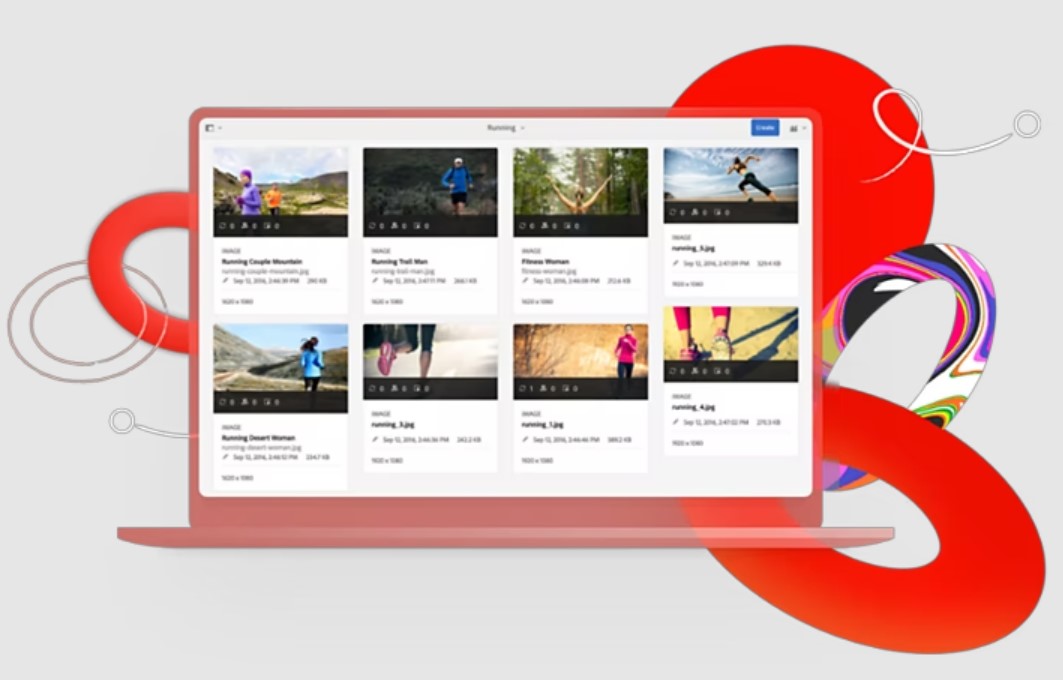
Adobe Experience Manager, abbreviated AEM, is a key product in the Adobe Experience Cloud family. Its only goal is to deliver a comprehensive content management solution that sets new industry standards. But what does it actually do?
In a nutshell, Adobe Experience Manager allows businesses to create, handle, and publish digital content. Well, it’s what Adobe Experience Cloud intends to do, so let’s be more specific.
The ability to manage content and assets in a centralized location is one of AEM’s key features. Since Experience Manager is the core instrument, it inherits numerous other advantages associated with Experience Cloud. For instance, businesses get all the necessary features to ensure that their digital assets are consistent and up-to-date across all channels.
You can count on AEM to create and manage digital assets, such as images, videos, and other media. Experience Manager delivers a powerful content authoring tool that includes a drag-and-drop interface, which is now an industry standard for all similar instruments. It empowers even non-technical users with the assets necessary to effortlessly create and publish content. Along with that, you get a range of templates and components that shorten your path to professional-looking content even more.
And since customer segmentation is also on your side, you can fully leverage it within Experience Manager to personalize the content you publish. AEM relies on data and insights from Adobe Analytics and other sources to help you tailor your marketing efforts to each customer’s needs and preferences.
Last but not least, AEM includes a range of tools for managing workflows and approvals. As a person responsible for that, you can review and approve all content pieces before they are published.
Read our Adobe Experience Manager review for more information.
Adobe Analytics: In-Depth Insights Into Your Customer Behavior
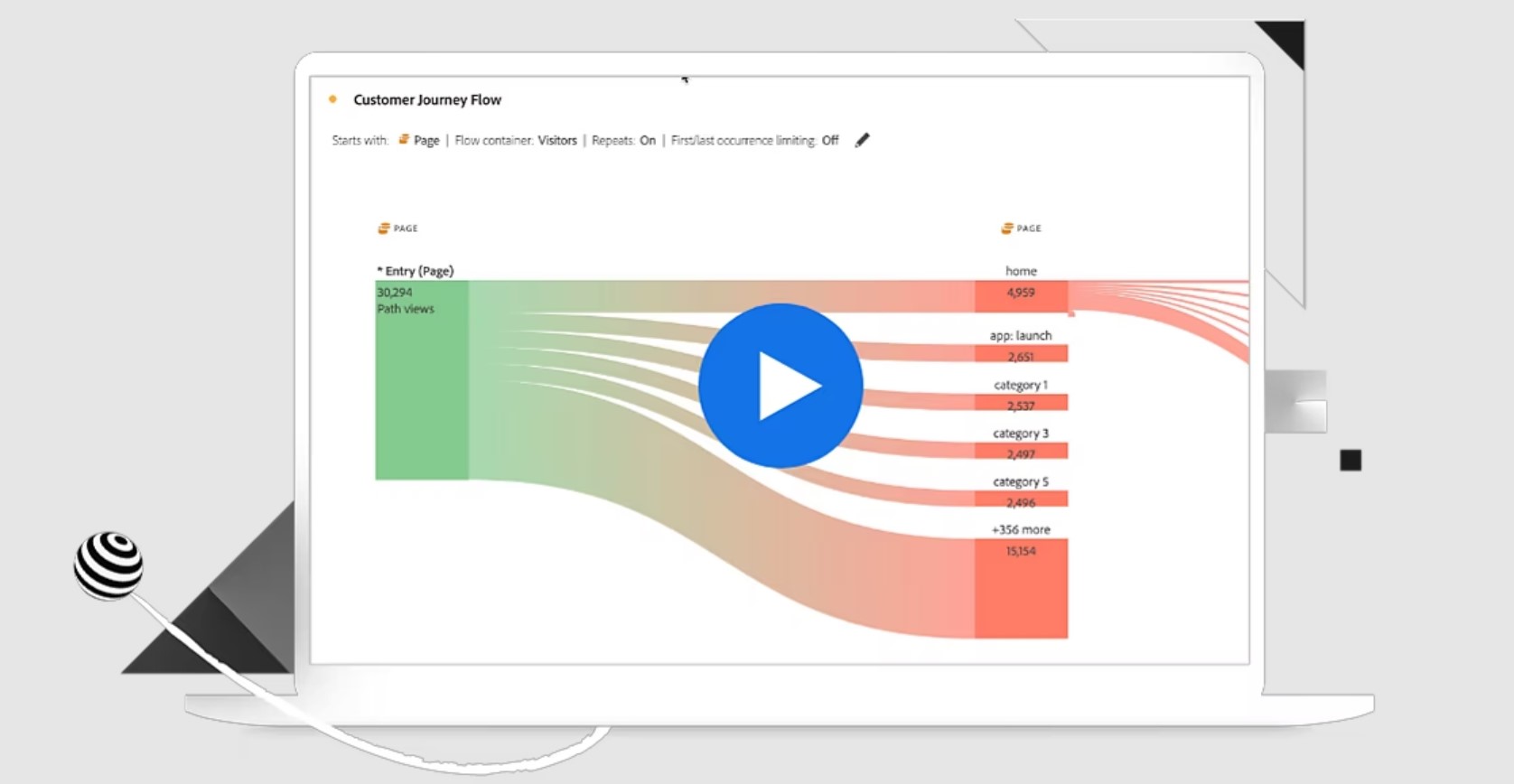
Analytics is another key product in Adobe Experience Cloud. And it’s not surprising. You need tons of data to gain insights into customer behavior and preferences to provide the most personalized digital experiences. To provide businesses and organizations with powerful analytics, Adobe introduces Analytics designed to help companies track and analyze customer interactions across multiple channels and touchpoints.
What makes Adobe Analytics really astonishing is its ability to track customer interactions in real time. You remove the veil of unawareness and see how customers are interacting with your brand and its digital properties in real time, identifying areas that need improvements.
Moreover, Adobe Analytics includes a range of tools for creating customized reports and dashboards. Consequently, you not only get real-time data but receive it in the most user-friendly manner.
Since this Adobe Experience Cloud product is tightly connected with other family members, you can also expect that its segmentation capabilities may impress you. Adobe Analytics introduces a range of segmentation tools that can help you identify and target specific customer segments with the highest possible precision. You can divide your customers into groups following such parameters as various demographic data, including age, gender, and location, as well as behavioral data, including purchase history and engagement levels. Take the most out of your marketing campaigns by running them among the right people.
Another good news is that you can share these excellent capabilities within the Adobe family. Yes, you got it right: Adobe Analytics is tightly integrated with other products within Adobe Experience Cloud. For instance, you can harness it to deliver data necessary for informed content creation and personalization within Adobe Experience Manager or optimize campaigns within Adobe Campaign.
What’s even more intriguing is Adobe’s ability to predict the future. Analytics includes a range of predictive analytics tools that can help you identify trends and patterns in customer behavior. Consequently, you can prepare for the next custom moves in advance, making data-driven decisions and surprising your prospects with content they wanted to see but didn’t realize.
Read our Adobe Analytics review to discover more facts about this product.
Adobe Target: Best Way To Target Your Clients
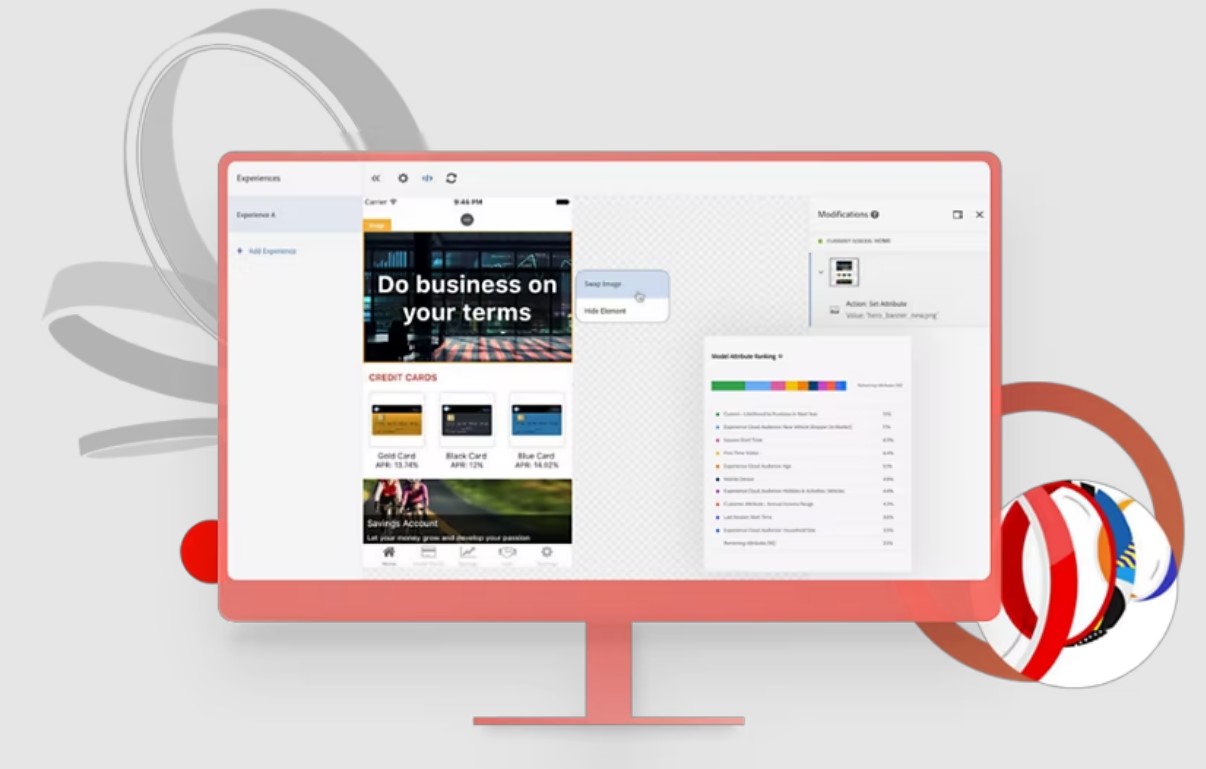
Adobe introduces Target to increase the precision of your marketing campaigns by personalizing digital experiences and optimizing content even more. This product helps businesses deliver personalized offers to customers based on their behavior, preferences, and other data, using AI-powered testing, personalization, and automation. Thus, you can evaluate your customer’s expectations and deliver the experiences they demand
As you might have already guessed Adobe Target heavily relies on data from Adobe Analytics and other sources. The more information it consumes, the more specifically targeted offers and content you can generate. And it results in better conversion, engagement, and so on.
Adobe Target also includes a range of optimization tools designed to help businesses test and refine their digital offers. For example, it provides the ability to test different versions of a website or landing page and then choose the one that performs the best. So, you get a better way to optimize your digital experiences.
Another Target’s key feature is its ability to integrate with other products within Adobe Experience Cloud. Think of it as a solution that connects not only to Analytics but also to Experience Manager. This integration can help you rise the degree of personalization to a completely new level.
And with a range of reporting and analytics tools, Adobe Target can help you gain insights into the performance of your campaigns. Track the performance of different offers or evaluate the efficiency of your content to refine your campaigns.
As for the AI-powered tools of Adobe Target, they can help you identify trends and patterns in customer behavior. Thus, this Adobe Experience Cloud product predicts which content is likely to perform the best based on multiple factors.
Read our Adobe Target review for more details.
Adobe Campaign: Marketing Automation Made Easy
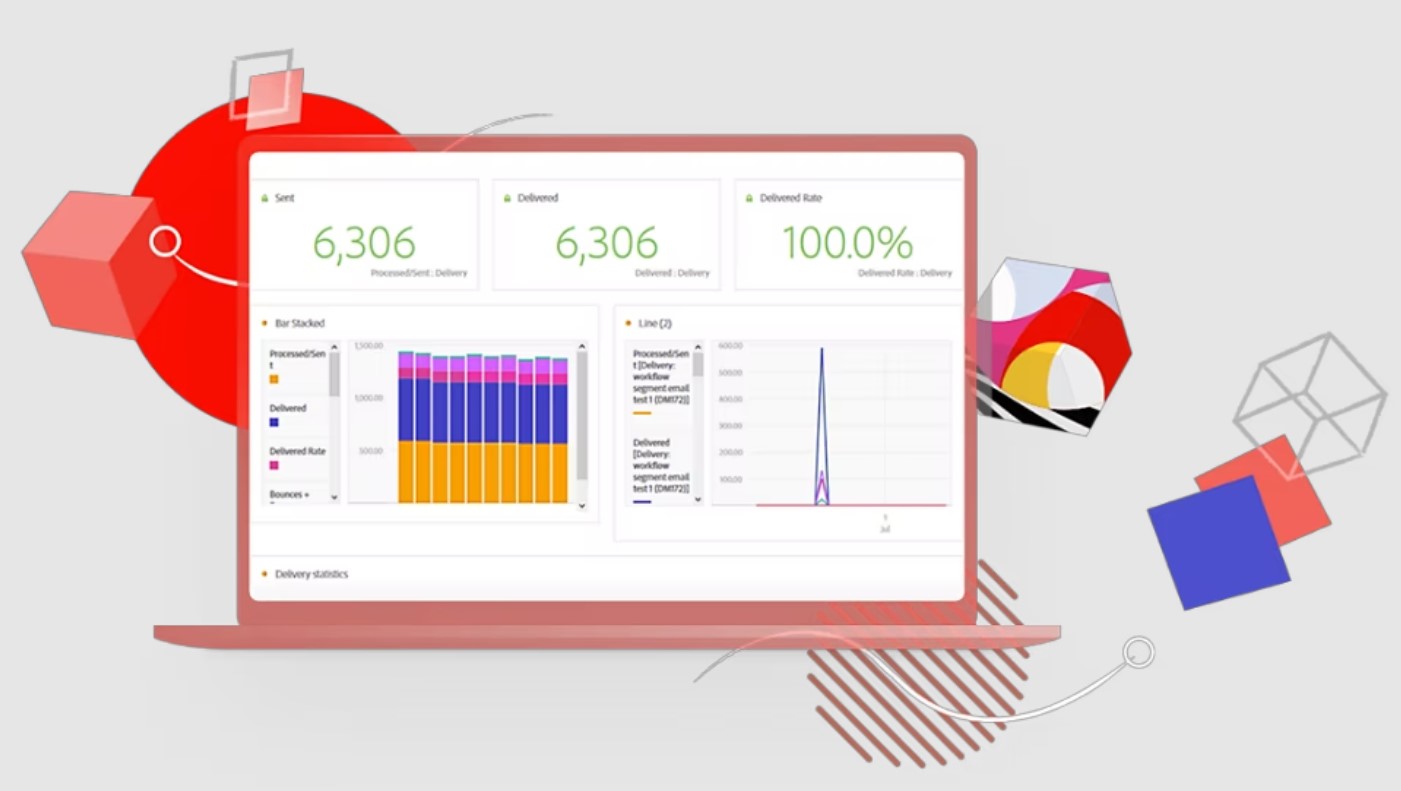
Adobe Campaign is a marketing automation platform. You can use it to automate your connections with customers by creating, coordinating, and delivering dynamic campaigns through emails and mobile.
Adobe Campaign is a product in Adobe Experience Cloud that provides businesses with a powerful solution for creating and managing cross-channel campaigns. Adobe Campaign is designed to help businesses deliver personalized and engaging campaigns across multiple channels, including email, mobile, social, and more.
One of the key features of Adobe Campaign is its ability to create and manage cross-channel campaigns. Adobe Campaign allows businesses to create campaigns that can be delivered across multiple channels, including email, SMS, push notifications, and social media. This can help businesses to reach customers wherever they are, and create more engaging and effective campaigns.
Adobe Campaign also includes a range of personalization tools that can help businesses tailor their campaigns to each individual customer. For example, businesses can use Adobe Campaign to create dynamic content that changes based on each customer’s behavior, preferences, and other data. This can help businesses to create more relevant and engaging campaigns, and increase engagement and conversions.
Another key feature of Adobe Campaign is its ability to integrate with other products within Adobe Experience Cloud. For example, Adobe Campaign can be used to personalize content and offers within Adobe Experience Manager, or to optimize campaigns within Adobe Target. This can help businesses to create more effective and cohesive campaigns across all of their digital channels.
Adobe Campaign also includes a range of reporting and analytics tools that can help businesses track the performance of their campaigns and gain insights into customer behavior. For example, businesses can use Adobe Campaign to track open and click-through rates for email campaigns or to track engagement levels on social media. This can help businesses to optimize their campaigns and improve their results.
Finally, Adobe Campaign includes a range of automation tools that can help businesses streamline their campaign management processes. For example, businesses can use Adobe Campaign to automate the delivery of campaigns based on predefined triggers or events, such as a customer making a purchase or signing up for a newsletter. This can help businesses to create more efficient and effective campaigns, and ultimately drive more revenue.
You can find more information in our Adobe Campaign review.
Adobe Commerce: Most Powerful E-Commerce Platform
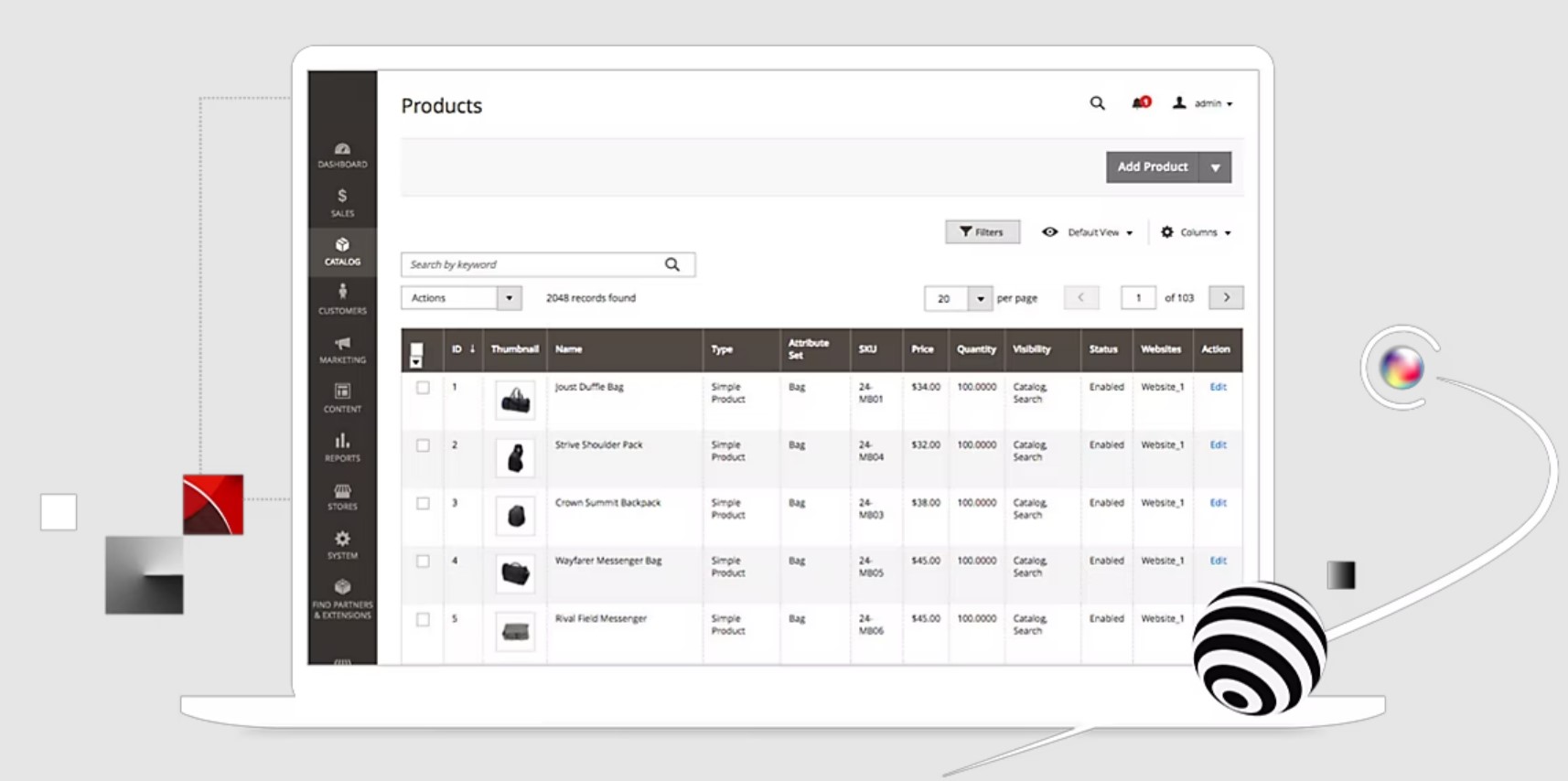
As we’ve already mentioned, Adobe Commerce is the most powerful and feature-rich variation of our favorite Magento 2. It is an ecommerce platform built on top of Magento Commerce that provides businesses with a comprehensive set of tools and features to create and manage their online stores and sell products and services online to both B2c and B2B clients.
Adobe Commerce includes a range of features such as product, customer, and order management, payment processing, shipping and fulfillment, analytics, etc. If the default functionality is not enough, you can leverage a wide range of integrations with third-party services, such as payment gateways, shipping carriers, and marketing automation tools, to achieve a more complete e-commerce experience.
One of the key benefits of Adobe Commerce is its flexibility and scalability. You can customize the platform to meet your specific business needs, whether you run a small online store or a large enterprise-level e-commerce site. With a range of deployment options, including cloud-based and on-premise, Adobe Commerce suits a variety of business needs.
You can learn everything about the platform’s features in our Adobe Commerce In-Depth Review.
Adobe Experience Cloud Advantages
Salesforce, Oracle, Microsoft Dynamics, and dozens of other software solutions are among Adobe Experience Cloud competitors. Each of these alternative products offers features and capabilities similar to Experience Cloud. However, they lack Adobe’s core advantages. Let’s take a look at the benefits of Adobe Experience Cloud that set it apart from opponents:
- Comprehensive Suite of Products. The selection of best-of-breed apps is Adobe Experience Cloud’s number one benefit. The platform includes a comprehensive suite of products designed to manage and optimize every aspect of the customer journey, from content creation and management to analytics and personalization. With these products, you can create more cohesive and effective experiences for your customers.
- Integration. Adobe Experience Cloud consists of numerous products which are tightly connected with one another. They not only exist under the common branding, but they also interact with one another. Furthermore, Adobe Experience Cloud integrates seamlessly with Adobe Creative Cloud, allowing you to manage various digital assets, including images, videos, and animations.
- Artificial Intelligence. Adobe Experience Cloud includes a range of machine learning and AI-powered features to make its products more efficient, precise, and easy to use. Thus, the platform leverages Adobe Sensei, which helps you gain insights into customer behavior and preferences, automating and optimizing marketing campaigns.
- Strong Analytics. With Adobe Analytics, Adobe Experience Cloud introduces a powerful analytics tool that allows businesses to gain insights into customer behavior and preferences across all channels. Such features as real-time analytics, data visualization, and predictive analytics can help you optimize your marketing and sales strategies. Note that they are powered with AI and enforced by other Adobe Experience Cloud products.
- Security and Compliance. Adobe Experience Cloud includes a range of security and compliance features that can help businesses protect their customer data and comply with data privacy regulations such as GDPR and CCPA. All Adobe Experience Cloud products are designed to be highly secure and compliant.
Adobe Experience Cloud Pricing
How much does Adobe Experience Cloud cost?
Adobe Experience Cloud pricing depends on what products you use and how you do that. The actual price is established on an individual basis and varies depending on the number of services, the needed capabilities, and continued consumption.
For instance, Adobe Commerce’s price starts at $22,000 per year. The higher your Gross Merchandise Value is, the more you have to pay. Also, Commerce’s price bumps if you want to use its cloud version.
You have to contact Adobe regarding Adobe Experience Cloud pricing details.
Conclusion
As you can see, Adobe Experience Cloud is a powerful tool for businesses and organizations looking into delivering personalized, seamless digital experiences to their customers. However, it is not suitable for everyone. First of all, it is way more complex than most small and medium businesses expect. Adobe Experience Cloud is perhaps the most powerful platform of its kind, but it doesn’t make it suitable for every business. Multiple successful competitors prove that.
However, you can grab all the necessary Adobe Experience Cloud products to gain a deeper understanding of your clients if you think this fully-features solution suits you. They will help you create more effective marketing campaigns and ultimately drive more conversions and revenue. Despite competitors, Adobe’s suite of products, strong analytics capabilities, AI-powered features, and tight integration with Adobe Instruments provide businesses with a range of benefits and advantages associated with engaging and effective digital experiences.
Adobe Experience Cloud FAQ
What is Adobe Experience Cloud?
Adobe Experience Cloud is a suite of digital marketing tools designed to help businesses deliver personalized customer experiences across multiple channels. The platform combines customer data, analytics, and content management capabilities, enabling businesses to better understand their clients.
What are the key Adobe Experience Cloud features?
Adobe Experience Cloud includes a range of tools and features:
– marketing campaign management;
– customer interaction tracking;
– performance analysis;
– content management capabilities;
– integration with other Adobe products.
How does Adobe Experience Cloud improve marketing efforts?
Adobe Experience Cloud provides businesses with a range of data-driven insights and tools to help them optimize their marketing campaigns, increase engagement, and drive conversions. It provides the ability to track customer interactions across multiple channels, analyze performance data in real time, and create personalized experiences that resonate with their audience.
Who can benefit from using Adobe Experience Cloud?
Although Adobe Experience Cloud is designed for businesses of all sizes, across a range of industries, it suits medium and big market players. It can be particularly useful for marketing teams looking to improve their campaigns, as well as businesses that want to create better customer experiences across multiple channels.
How easy is it to use Adobe Experience Cloud, and what kind of support is available?
Adobe Experience Cloud is user-friendly and intuitive with a range of training resources and support options, including online tutorials, user forums, and access to Adobe’s customer support team.









